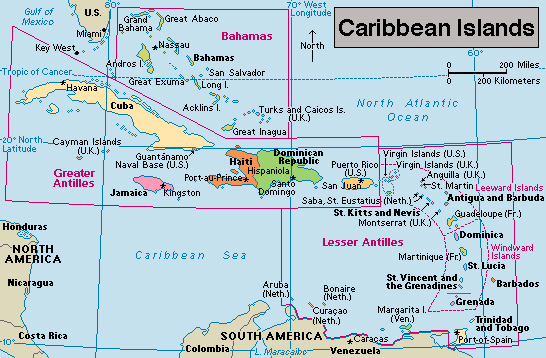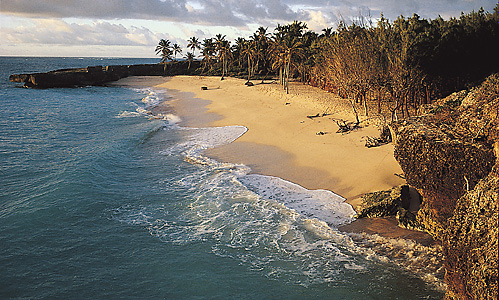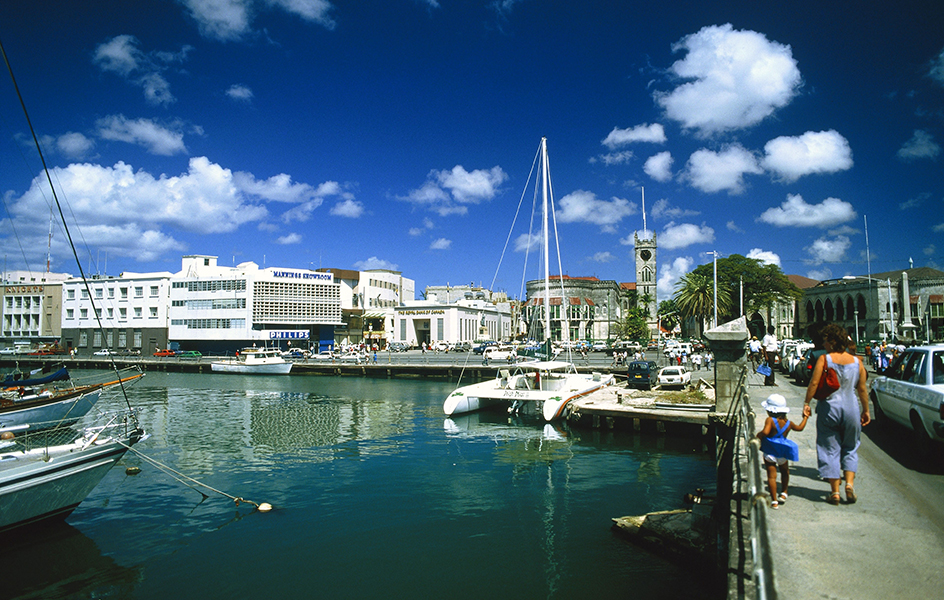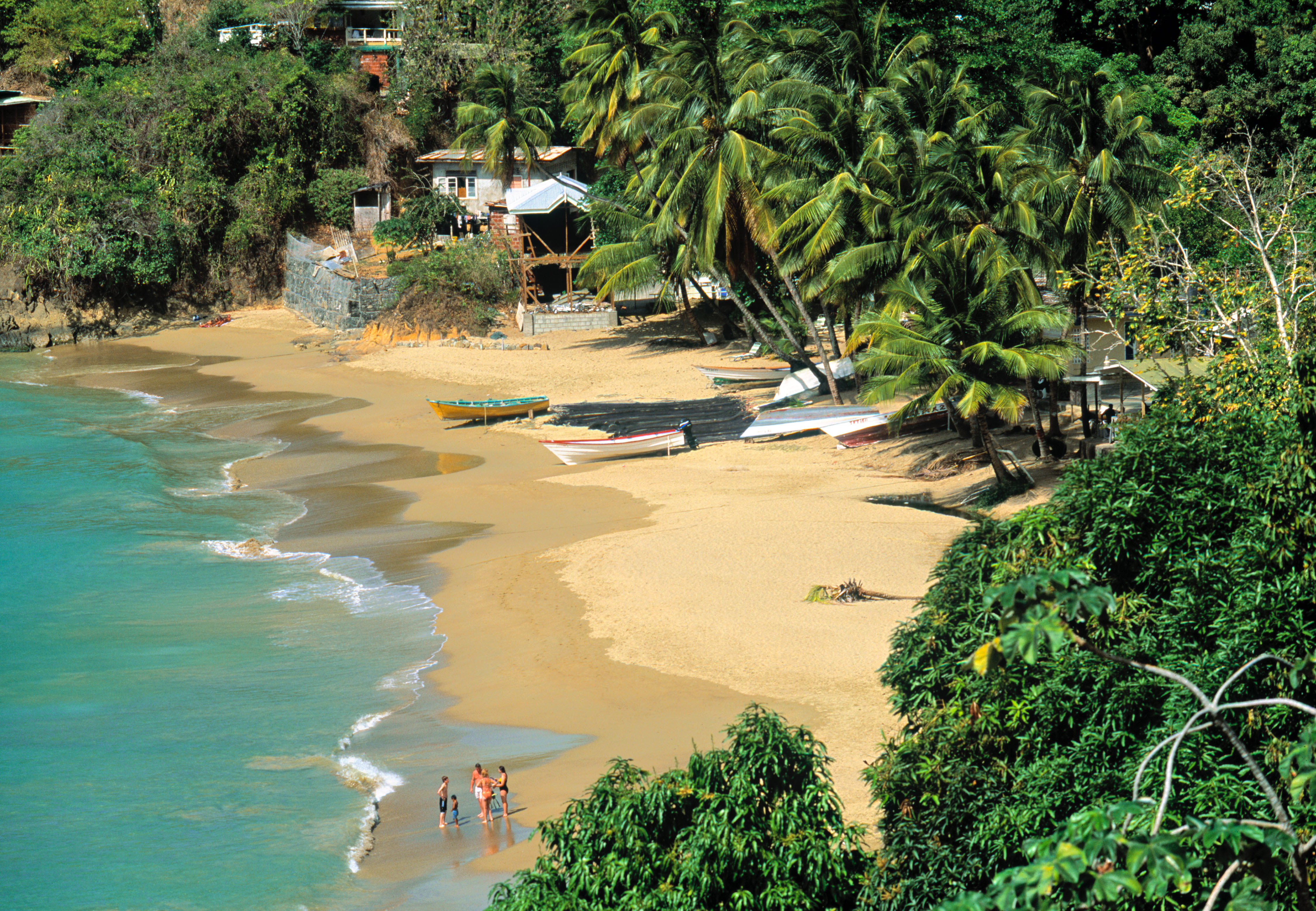Caribbean Islands are an island chain that divides the Caribbean Sea from the rest of the Atlantic Ocean. The islands stretch about 2,000 miles (3,200 kilometers) from near southern Florida to Venezuela’s northern coast. Historically, the name West Indies has been used to describe all of the islands in the Caribbean Sea. Today, however, many people use the name to describe only the English-speaking parts of the Caribbean region, including Guyana on the mainland of South America.

Three main island groups make up the Caribbean Islands. They are (1) the Bahamas in the north, (2) the Greater Antilles near the center, and (3) the Lesser Antilles in the southeast. The Bahamas consist of about 3,000 small islands and reefs. The Greater Antilles include the large islands of Cuba, Jamaica, Hispaniola, and Puerto Rico. Hispaniola is divided into two countries—the Dominican Republic and Haiti. The Lesser Antilles are smaller islands southeast of Puerto Rico. They are divided into two groups, the Leeward Islands and the Windward Islands. All the Caribbean Islands except the Bahamas are sometimes called the Antilles. The warm and sunny climate, beautiful beaches, and tropical scenery of the Caribbean Islands attract many tourists.

The first inhabitants of the Caribbean Islands were Indigenous (native) people. In 1492, Christopher Columbus became the first European to reach the islands, when he landed on an island believed to be present-day San Salvador in the Bahamas. He called them the Indies because he believed they were the East Indies islands of Asia. The islands were later given the name West Indies to distinguish them from the Asian islands. Today, many people simply call the region the Caribbean.
After Columbus visited the region, various European countries gained control of the Caribbean Islands. Today, most of the islands make up, or form part of, independent nations. The rest are associated with the United Kingdom, France, the Netherlands, or the United States. For lists of the independent nations and the other political units of the Caribbean Islands, see the tables in this article
People
Population and ancestry.
The Caribbean Islands have a population of about 44 million. About a fourth of the people live on Cuba, the largest of the islands. Some of the Caribbean Islands are among the world’s most densely populated places.
A majority of the people of the Caribbean are descendants of Black Africans who were brought to the islands and enslaved to work on sugar cane or coffee plantations. Most of the rest are of mixed Black and European ancestry, or have British, Dutch, French, Portuguese, or Spanish ancestry. A significant number of people are descended from farmworkers, mainly East Indians and Chinese people, who arrived in the middle to late 1800’s, after slavery was abolished. These farmworkers were indentured servants—that is, people who worked without wages for some time in exchange for passage to America. The area’s original Indigenous population largely has died out or mixed with other ethnic groups. A small group of Indigenous Carib people remains on Dominica.
Languages.
The many languages and dialects spoken in the Caribbean reflect the dominant cultural heritage of the European groups that colonized the region. More people speak Spanish than any other language. Places where Spanish is spoken include Cuba, the Dominican Republic, and Puerto Rico. Haitian Creole, spoken by most Haitians, is the second most common language. French is the official language of Guadeloupe, Martinique, Saint-Barthélemy, and Saint-Martin. It is also an official language of Haiti. English is widely spoken in other parts of the region, for instance in Jamaica and in Trinidad and Tobago. Dutch is the, or an, official language of Aruba and other islands that are part of the Kingdom of the Netherlands. Many local people use a patois (dialect) that mixes African languages and mainly English or French. A dialect called Papiamento, which is a combination of chiefly Dutch, English, Portuguese, and Spanish, also is spoken on several islands.
Way of life.
About 70 percent of the people of the Caribbean Islands live in urban areas, and about 30 percent live in rural areas. Most of the cities and towns lie along the islands’ coasts. These modern urban centers include such large cities as Havana, Cuba; Kingston, Jamaica; San Juan, Puerto Rico; and Santo Domingo, Dominican Republic. They also include smaller towns, such as Bridgetown on Barbados and Roseau on Dominica. Many urban people work in business or government offices, stores, small factories, or in services related to tourism. The urban areas attract many rural people seeking a better way of life. But many of these people end up in crowded slums. The urban areas have a wide variety of housing, including shacks, modern suburban homes, high-rise apartments, and mansions.

The Caribbean Islands have few natural resources except for their land, so agriculture is an important way of life. Many people work on large sugar cane plantations that belong to wealthy landowners. Some people own or rent small plots of land on which they raise crops and livestock. Many families must struggle to produce enough food for their own needs. Most of the rural people live in small, one- or two-room wooden houses.
Because of the warm weather, clothing in the Caribbean tends to be light and loose. Hats are popular because they provide protection from the sun. The diet of most local people includes rice, beans, goat stew, pork, fish, and such tropical fruits as bananas, oranges, papayas, and plantains. Soft drinks, beer, and rum rank as favorite beverages. There are also restaurants that offer various non-Caribbean cuisines, such as Chinese food, especially in large urban areas.
Religion.
Most of the people of the Caribbean Islands are Christians. Roman Catholicism is the main religion on the Spanish- and French-speaking islands. The English- and Dutch-speaking islands have a mixture of Catholics and Protestants. Small groups of Hindus, Jews, and Muslims also live in the Caribbean. On several of the islands, people practice religions with traditional African influences. For example, Vodou (sometimes called Voodoo) is practiced on Hispaniola. Ras Tafari, a religious group that worships former Emperor Haile Selassie I of Ethiopia as God, has numerous followers on Jamaica and several other islands. See Vodou .
Education.
Government-sponsored elementary and secondary education is available throughout the Caribbean. But schools in rural areas often face shortages of teachers and equipment, and many students drop out and get jobs to help support their families. The Caribbean Islands have a number of colleges and universities, but many students go abroad to college. Many islands have technical schools that prepare people for careers in agriculture, engineering, tourism, and other fields.
Recreation.
Popular sports in the Caribbean include baseball, basketball, cricket, soccer, and track and field. Music, including calypso, meringue, reggae, and salsa music, is a favorite form of recreation. Most people enjoy performances of traditional songs and dances, and festivals are widely celebrated.
Land and climate
The Caribbean Islands cover a land area of about 90,000 square miles (234,000 square kilometers). The islands are spread out over a huge crescent more than 2,000 miles (3,200 kilometers) long. They are part of an underwater mountain chain that linked North and South America in prehistoric times. Many of the islands were formed by volcanoes. Others were formed after wind and rain wore down the mountain peaks. These islands are mostly flat strips of coral and limestone.
Volcanic mountains rise on a number of the islands. Several volcanoes have erupted in the last 500 years. They include Mount Pelée on Martinique, Soufriere on Basse-Terre Island in Guadeloupe, and another volcano called Soufrière on Saint Vincent. Other islands have boiling sulfur springs and inactive volcanic craters. Duarte Peak in the Dominican Republic on Hispaniola is the highest peak in the Caribbean Islands. It rises 10,417 feet (3,175 meters) above sea level. Fertile lowlands and sandy beaches line the coasts of many islands.
The Caribbean Islands have a number of fine harbors, and many islands have numerous bays and inlets along their coasts. Swift-flowing rivers run on many islands, but most can only be navigated by small boats. The Puerto Rico Trench, which lies off the northern coast of Puerto Rico, is one of the deepest spots in all the world’s oceans. It descends to 28,232 feet (8,605 meters) below the ocean’s surface.
Plant and animal life.
Lush tropical vegetation covers many of the Caribbean Islands. Mangrove swamps, shrubs, grasses, and cactuses are common. The region’s many flowering plants include bougainvillea, hibiscus, orchid, and poinsettia. Palms and citrus trees flourish.
Bats, frogs, lizards, rodents, and many species of birds live on the islands. There are no large wild animals. Dolphins, tropical fish, and such game fish as barracuda, marlin, and sailfish thrive in the blue-green waters surrounding the Caribbean Islands.
Climate.
The Caribbean Islands have warm, tropical and subtropical climates. Steady ocean winds keep temperatures mild all year. Temperatures average about 80 °F (27 °C) in the summer and about 75 °F (24 °C) in the winter.
Rainfall in the Caribbean Islands ranges from 20 inches (50 centimeters) a year in some places to as much as 200 inches (500 centimeters) a year in mountainous areas. Most islands have alternate wet and dry seasons, with heavy showers common during the wet season. Hurricanes frequently strike the region, chiefly in late summer and early fall. They often cause severe damage.
Economy
Agriculture and tourism rank as the chief economic activities of the Caribbean. Farming employs more than 40 percent of the work force. About 40 percent of the employed people work in government, tourism, or other service jobs. Most of the rest work in manufacturing, mining, or fishing. Unemployment is a problem.
Agriculture.
Sugar cane is the area’s leading crop. It is grown chiefly for export on large plantations. Other export crops include bananas, cacao (used to make chocolate), citrus fruits, coffee, tobacco, and spices. Farmers grow beans, carrots, sweet potatoes, tomatoes, and other crops throughout the Caribbean Islands. They also raise cattle, goats, pigs, and other livestock. However, many islands cannot produce enough to feed their people and must import food.
Tourism.
More than 8 million people visit the islands each year to enjoy the sunny climate, beaches, and scenery. Many people tour the islands on cruise ships.
Manufacturing
in the Caribbean includes the production of cement, clothing, electrical parts, pharmaceuticals, plastics, and rum. Oil refineries on Curaçao process oil from Venezuela and other countries.
Mining
is unimportant in most of the Caribbean Islands. There are some important deposits of oil, natural gas, and asphalt on Trinidad. Jamaica is a leading producer of bauxite. Cuba and the Dominican Republic have large deposits of iron ore and nickel.
Fishing.
Bonitos, sharks, tuna, and such shellfish as clams, crabs, and lobsters live in the waters surrounding the Caribbean Islands. Almost all the fish that are caught are sold mainly in markets throughout the Caribbean Islands.
Trade.
The main exports of the Caribbean Islands include assembled goods, bananas, petroleum products, rum, and sugar. Imports include food, manufactured products, and raw materials. Canada, the United Kingdom, and the United States are the area’s main trading partners. A number of Caribbean countries belong to the Caribbean Community (CARICOM), an economic union that encourages trade among its members.
Transportation and communication.
Most major Caribbean cities have an international airport. Regional airlines serve smaller islands. Cargo and passenger ships from around the world visit Caribbean ports. Paved roads link major cities with rural areas on most islands. Satellites beam radio and television programs from Europe and the United States to the Caribbean. Most of the islands have at least one daily newspaper.
History
Early days.
Indigenous Ciboney people were the first inhabitants of the Caribbean Islands. They began living there during prehistoric times. Indigenous Arawak people from South America moved to the Caribbean between about 200 B.C. and A.D. 1000. They eventually settled in the Greater Antilles. About A.D. 1300, the Arawak were followed by the more warlike Carib, who populated most of the Lesser Antilles. Both groups grew crops near their villages. The people also fished, hunted, and gathered wild plants for food.
The colonial period.
Christopher Columbus landed on a Caribbean island in 1492. The island probably was present-day San Salvador, in the Bahamas. During the next 10 years, he reached, and claimed for Spain, almost all the Caribbean Islands. The Spanish set up the first permanent European settlement in the islands in 1496 at Santo Domingo on Hispaniola. The search for gold and other riches drew thousands of Europeans to the region. In the early 1500’s, Spaniards founded colonies on Cuba, Jamaica, and Puerto Rico. They enslaved the Indigenous people and forced them to work in gold mines. Disease and overwork and other harsh treatment killed most of the Indigenous people.
Other Europeans learned of the wealth of the Caribbean. Pirates from England, France, and the Netherlands attacked Spanish ships and ports and stole valuable cargo. In the 1600’s, the Danes, Dutch, English, and French established colonies on the smaller islands. The British invaded Jamaica in 1655. They gained formal possession of the island from the Spanish in 1670. The French took control of the western third of Hispaniola in 1697.
In the late 1600’s and 1700’s, the colonial powers gained great wealth from sugar cane and other crops grown in the Caribbean Islands. During this period, Europeans forcibly transported millions of Black Africans to the islands and enslaved them on large plantations.
Abolition and independence movements.
During the 1800’s, revolutions weakened colonial control on several islands. In 1804, Haiti became the first independent nation in the Caribbean after enslaved people on Hispaniola, led by Toussaint Louverture and others, rebelled against their French rulers. The Dominican Republic broke off from Haiti and declared independence in 1844. Slavery was abolished in all of the Caribbean Islands by the late 1800’s. The plantation system then became much less profitable because plantation owners lost most of their cheap labor. As a result, European interest in the Caribbean declined.
The United States began playing an active role in the Caribbean in 1898. That year, a revolution in Cuba drew the United States into the Spanish-American War against Spain. After the United States won the war, Cuba became independent and Puerto Rico became a U.S. colony. In 1917, the United States purchased what are now the U.S. Virgin Islands from Denmark.
Dictators controlled Cuba, the Dominican Republic, and Haiti during much of the first half of the 1900’s. In 1959, Fidel Castro overthrew the government of Cuba and established a Communist state.

Many Caribbean Islands have become independent or have gained more control over their own affairs since 1945. Both the Netherlands Antilles and Puerto Rico gained almost complete self-government in the early 1950’s. Ten British colonies formed the West Indies Federation in 1958. They were Antigua, Barbados, Dominica, Grenada, Jamaica, Montserrat, St. Christopher-Nevis-Anguilla, St. Lucia, St. Vincent, and Trinidad and Tobago. The federation was dissolved in 1962 after Jamaica and Trinidad and Tobago became independent.
In the late 1960’s, Antigua, Dominica, Grenada, St. Christopher-Nevis-Anguilla, St. Lucia, and St. Vincent became states associated with the United Kingdom. Together, the six states were called the West Indies Associated States. By the early 1980’s, all of the West Indies Associated States except for St. Christopher-Nevis-Anguilla had become independent nations. In 1980, Anguilla officially became a separate British dependency (now known as an overseas territory). The rest of the state became independent in 1983 as a nation called St. Christopher and Nevis. This nation is now known as St. Kitts and Nevis.
In 2005, the Dutch government and the leaders of Bonaire, Curaçao, Saba, Saint Eustatius, and Saint Martin agreed to dissolve the Netherlands Antilles. The five islands became separate political units within the Kingdom of the Netherlands in 2010.
For the year of independence of all the countries of the Caribbean Islands, see the table in this article.
The early 2000’s.

Several hurricanes struck the Caribbean Islands in the early 2000’s, resulting in a significant number of deaths and property damage. Hurricane Sandy caused dozens of deaths and extensive crop and property damage on several Caribbean islands in October 2012. Haiti and eastern Cuba were hit the hardest. Other places that reported deaths from the storm included the Bahamas, the Dominican Republic, Jamaica, and Puerto Rico.

In September 2017, Hurricane Irma devastated parts of Antigua and Barbuda; the islands of Anguilla, Saint-Barthélemy, and Saint Martin; and the British and U.S. Virgin Islands. Two weeks later, Hurricane Maria swept across the Caribbean region, causing extensive damage in Dominica, Puerto Rico, and other islands. The two storms together killed about 3,000 people.
Hurricane Dorian devastated much of Grand Bahama and the Abaco islands in the northwestern part of the Bahamas in September 2019. At least 70 people were killed, and many others were reported missing.
